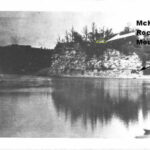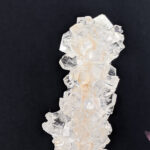Among the remarkable discoveries within the Galloway Hoard, a collection of Viking-age artifacts unearthed in Britain, lies an extraordinary object: a Rock Crystal vessel adorned with intricate goldwork. This piece, shrouded in layers of history and mystery, presents a unique glimpse into the past, revealing a story that spans centuries and cultures. The rock crystal artifact, carefully preserved within a silver-gilt container, stands as a testament to the artistry and global connections of the Viking Age and beyond.
The Galloway Hoard, buried around AD 900, is celebrated as the most substantial assembly of rare and exceptional Viking-era objects ever found in Britain or Ireland. Within this treasure trove, the rock crystal object was discovered among several items meticulously enveloped in textiles, forming part of the hoard’s lower deposit. These wrapped bundles are currently undergoing extensive conservation and research, a project dedicated to unveiling the secrets held within these ancient layers.
The triple-layered, silk-lined leather pouch containing the gold-mounted rock crystal jar as first seen in the conservation lab. Museum reference X.2018.12.71.18.2.
Discovery of the Rock Crystal Jar
The unearthing of the wrapped bundle containing the rock crystal and gold artifact marked a pivotal moment in the Galloway Hoard’s exploration. The layers of wrapping themselves spoke volumes about the object’s precious nature. Initially encased in linen, it was then placed within a delicate leather or suede pouch. Intriguingly, a layer of samite, a luxurious silk originating from Byzantium or Asia, was found nestled between these layers. This silk, a valuable material in its own right, served as an inner lining for the pouch, underscoring the significance attributed to the object within.
Upon removal of the bundle, AOC Archaeology meticulously documented it using X-radiography. These initial X-ray images offered the first tantalizing glimpses of the enigmatic object concealed beneath its ancient wrappings. The images revealed a carved rock crystal form, embellished with elaborate gold meshwork and what appeared to be a spout at its apex.
Further investigation involved collaboration with Dan O’Flynn from the British Museum’s Department of Scientific Research. Together, they conducted 3D X-radiography, a technique that allowed for a non-invasive exploration of the bundle’s interior. Over a thousand X-ray scans, captured from every conceivable angle, were digitally stitched together to construct a comprehensive three-dimensional model of the object within. This innovative approach allowed researchers to scrutinize the rock crystal object and its gold meshwork in unprecedented detail, all while preserving the integrity of the fragile textile wrapping. This enhanced understanding paved the way for informed planning of subsequent research and conservation efforts.
X-ray showing the gold meshwork, base and cap with spout.
At a different voltage, the X-ray shows the jar in its silk-lined leather pouch.
An Ancient Roman Artifact
The 3D digital model affirmed that the rock crystal was pierced through its center, aligning with the spout at the top, confirming its nature as a small jar. Intriguingly, a faint inscription in gold was detected on the base, although still obscured by the wrapping at this stage. Attention then turned to the carved rock crystal itself, discernible in profile even through its coverings. The distinctive shape of the carving hinted at a much more distant past.
Carved rock crystal was an exceptionally rare material in early medieval Britain and Ireland. Finding crystal of such clarity was a significant challenge. Moreover, rock crystal’s inherent hardness demanded specialized expertise for carving, a skill not commonly found in the ancient world outside of Imperial Rome’s workshops. While production centers re-emerged in the Islamic Caliphate later in the 10th century, the Galloway Hoard predates this resurgence.
The wear patterns on the carved lobes encircling the rock crystal’s surface provided further clues. The rounded, abraded edges of these leaf-like protrusions suggested considerable age or prolonged use. Given rock crystal’s hardness, such wear would necessitate a substantial period of time or extensive handling, pointing towards a considerably earlier origin for the carving. The leaf-like forms themselves, when viewed upside down, bore a striking resemblance to acanthus leaves from the capital of a Corinthian column, a hallmark of Classical architecture. Unworn areas revealed intricate details carved into the crystal, such as delicate leaf stems. The round top of the jar, when inverted, further reinforced the idea that it was originally connected to a column base.
Corinthian column of Classical architecture Credit: Michael Gunther, Wikimedia Commons
Galloway Hoard rock crystal jar turned upside down
Miniature, architecturally-inspired pieces crafted from carved rock crystal were indeed known in the Roman Empire. Rock crystal columns, remarkably similar in size to the Galloway Hoard object, are preserved in the Vatican collections in Rome, with one originating from the early Christian catacomb of Domitilla. These small crystal columns exhibited varied forms, although the Corinthian capital style is unique to the Galloway Hoard example. A common feature was a centrally drilled cavity, possibly intended to secure separate column components. It appears the Galloway Hoard rock crystal was originally a Corinthian column capital, likely part of a larger, Roman-era object.
Repurposed and Reimagined in the Viking Age
The evidence suggests that the rock crystal column capital was treasured as an heirloom for centuries. At some point, hundreds of years after its Roman creation, this column capital was ingeniously repurposed. It was inverted and transformed into a gold-mounted jar, with a spout meticulously aligned with the pre-existing central drilled channel.
The goldwork adorning the jar is equally exceptional. While filigree, a decorative technique using fine gold wire, was employed in numerous early medieval objects, the complexity of this example is striking. Unlike typical Anglo-Saxon filigree which often incorporates beaded wire, this piece is characterized by spirals of twisted wire and granulation – minute gold spheres individually soldered onto the surface. Plaited wire intricately binds the top of the vessel to the meshwork enveloping the carved rock crystal. The baseplate exhibits a similar, yet distinct, filigree technique. The unparalleled quality of the goldwork indicates its creation in a workshop of the highest caliber.
The central channel, originally drilled when the rock crystal served as a column component, was skillfully aligned with the gold spout at the top of the repurposed jar. This suggests the jar was intended to hold a small quantity of liquid, although whether the gold base rendered it watertight remains uncertain. The translucence of the rock crystal also raises the possibility that it might have contained a solid object. Regardless of its contents, it is clear that the jar held something of immense value. Its lavish wrapping further reinforces the notion that the jar and its contents were treated as sacred relics.
The gold baseplate of the rock crystal jar, showing a Latin inscription rendered in gold wire and granulation. The name Hyguald begins at the top left corner. Credit: Neil Hanna
The Inscription and Bishop Hyguald
The most unexpected revelation from the 3D X-radiography was the presence of an inscription on the gold baseplate. Initially challenging to decipher, the letters, formed from gold wire and granulation consistent with the jar’s ornamentation, gradually became legible upon closer examination, particularly after the textile wrapping was removed. The inscription reads:
+ H Y G V A L D E P : F A C : I U S S
This Latin inscription translates to:
+ Bishop Hyguald ordered [this] to be made
(Reading confirmed by Elisabeth Okasha, University College Cork)
The identity of Bishop Hyguald remains an active area of research. No bishop of this name is currently documented in historical records. However, other individuals named Hyguald are recorded in early medieval Northumbria, the kingdom encompassing present-day Galloway. The Durham Liber Vitae, a register of individuals associated with the monastic community of St Cuthbert, lists several Hygualds, none identified as bishops. Nonetheless, gaps in historical source material from the ninth century onwards exist. It is plausible that Hyguald was an unrecorded Northumbrian bishop from this period.
An Ongoing Investigation
Further analysis of the rock crystal object promises to yield more insights into its origins, creation date, and intended purpose. However, certain aspects are already evident. Like the silver arm-rings bearing Anglo-Saxon runes, a pendant incorporating an early 9th-century Mercian coin, and now the inscription bearing the name of a Northumbrian bishop, this artifact increasingly connects the Galloway Hoard to the Anglo-Saxon world. It is important to remember that much of what constitutes southern Scotland today was part of the Northumbrian kingdom for over two centuries prior to the hoard’s burial.
Alongside the pectoral cross discovered in the upper layer of the Hoard, the rock crystal jar suggests that some objects within the Galloway Hoard were once possessions of the Christian Church. The meticulous wrapping of the rock crystal jar offers a glimpse into the methods of preserving and transporting precious relics during this era. It also underscores the wealth of the Church in what would become Galloway, even during the Viking Age’s zenith. The rock crystal treasure continues to be a source of fascination and study, illuminating the intricate tapestry of history woven within the Galloway Hoard.

